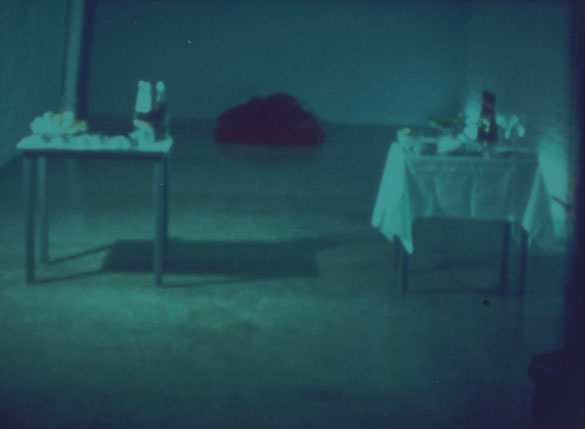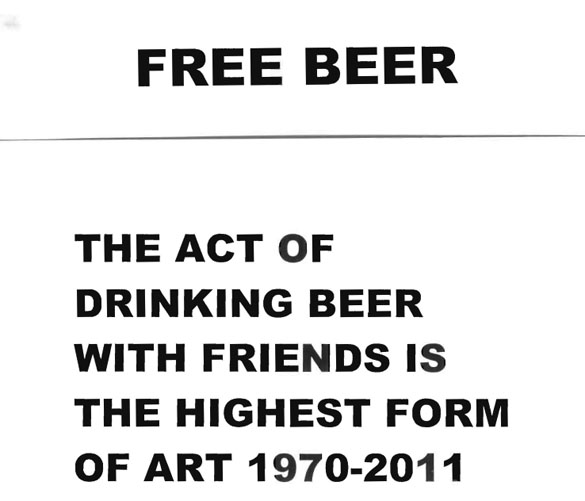November 2011 Archives

Thirty-two years ago today, the performance artists Marina Abramović and Ulay celebrated their shared birthday by creating a beautiful and little-known performance work, Communist Body / Fascist Body. This work is one of the centerpieces of Feast, so today is the perfect moment to introduce it to you.
(It's also a great moment to mention that we're partnering with the Chicago Humanities Festival to bring Marina in to give a lecture on February 16, 2012. She's one of the most brilliant -- and occasionally controversial -- artists of our time.)
Communist Body / Fascist Body is part of a rich body of collaborative work produced by Abramović and Ulay. They collaborated for over a decade, beginning in the mid-1970s when Abramović moved to Amsterdam from her native Serbia (then Yugoslavia). Partners in both art and love, they used their own bodies and psyches as primary material for their art.
Many of their works took the form of pared-down actions that extend to physical and mental extremes. In Breathing in, Breathing Out (1977), for instance, they locked lips, breathing in the stale air from each other's exhalation, pushing to the edge of physical collapse. Simple in structure, their performances were often meant to engage the audience's response on an emotional--even primal--level while also evoking heady topics like the boundaries of self, the limits of the body, and the power dynamics inherent to any interpersonal relationship. The pair famously ended their collaboration with the performance The Lovers: The Great Wall Walk (1988) in which they walked from opposite ends of the Great Wall of China, meeting briefly in the middle as the final moment in their collaborative practice.
Abramović and Ulay's original performance of Communist Body / Fascist Body took place one evening in 1979, when the artists invited a small group of friends to come to at their Amsterdam apartment just before midnight on their shared birthday. The unsuspecting guests arrived to discover a tableau arranged by the artists -- two tables, one beautifully set with silver, crystal, German champagne, white bread, and caviar, the other set with cheap Russian versions of the same (e.g. toilet paper rather than damask napkin). Their birth certificates were displayed on a third table. In the back of the space, the Abramović and Ulay lay on a low mattress, under a red blanket, apparently asleep.
Communist Body / Fascist Body feels like one of the real finds of the exhibition. It's a rich and moving work and one that should be much better known than it is. I first came across references to the piece last year while researching Feast, and found descriptions of the performance fascinating especially in terms of the complex relationships that it established among the participants.
The tableau contrasted the fact of the quietly sleeping, united couple with a geopolitical opposition that foregrounded their roles as separate beings, whose selves were shaped by everything they ingested growing up in different nations, ideologies ,and economies. It also upended the usual kinds of interaction between host and guest. The hosts were present -- physically there -- but also absent -- asleep (or performing sleep) and so not attending to any of the host's usual duties of welcome or attention. The guests responded in different ways to this surreal repast -- some were disturbed, others relaxed and convivial -- but eventually they embraced the situation, popped the champagne, and enjoyed the party.
We know about the guests' richly varied reactions because Abramović and Ulay wove documentation into the fabric of the performance: a friend filmed the evening, and then edited that footage together with audio interviews that they conducted with their guests a few weeks later. They completed the loop by screening the resulting film to their guests in the same space in which the performance occurred, three months later.
So, although Abramović and Ulay established the original work as a closed circuit, they always meant for it to have a life for an audience beyond that initial circle of participants. Until now, the work has only been shown rarely, as a film. On the occasion of Feast, Abramović and Ulay have decided to embrace the issue of re-performance in a new way by creating a fresh version of this work: an installation that recreates the original setup (tables, bread, and champagne, bed) with the original video projected in the space as a way of anchoring and vivifying the video's evocation of that original meal.
The Smart is thrilled to be collaborating with the artists to produce this new version of the work. And it's personally deeply moving to me as a curator to see how much it means to the artists to be revisiting this work, after so many years, together.
Above: Marina Abramović and Ulay, Communist Body / Fascist Body, Performance, Zoutkeetsgracht 116 / 118, Amsterdam, November 30, 1979. Courtesy of the Marina Abramović Archives. © Marina Abramović.
 By Alice Kain
By Alice KainStudy Room Supervisor, Smart Museum of Art
Theaster Gates is currently collaborating with three Japanese potters as part of his Soul Food Pavilion project for Feast. The potters recently travelled to Chicago to make dishes for the soul food ceremonies, which will be held at Theaster's Dorchester Project.
On their recent visit to Chicago the potters, Kouichi Ohara, Haruka Komatsu, and Yoko Matsumoto, were able to spend time with some of the ceramics in the Smart Museum collection. The potters, and Theaster's assistant Marlease Bushnell, were shown examples of Korean ceramics chosen for them by Richard Born, Senior Curator at the Smart. They were also shown a selection of Classical Greek ceramics by Richard Neer, Professor of Humanities and Art History at the University of Chicago. This combination provided an interesting juxtaposition of the familiar --Kouichi was especially knowledgeable about the 12th century Korean pieces-- and the unfamiliar, particularly with the methods used by the Ancient Greek potters. Initially the visit had been scheduled to take place in the Smart museum study room, but the number of ceramics to be shown became far too large for this space! The museum holds a culturally wide and valuable collection of ceramics, many of which are kept in storage and mainly used for research purposes. It was in this museum storage area that the potters were to have an up close encounter with some of these pieces. The potters were excited to have the opportunity to see the dishes and bowls without a glass vitrine.
Richard Neer provided an excellent narrative to the Greek pottery on display, explaining the particular method of clay slips and low oxygen firing that produced the familiar black and red figure glazes. A highlight was Richard's demonstration of a popular Greek drinking game. Using the Dionysus wine bowl as an example, he showed the potters how the Ancient Greeks would swirl the last dregs of wine in their cups and then throw them at a target on the wall! The Dionysus bowl particularly caught the potters' imaginations, as the painted eyes on the underside of the cup would have provided a facial mask for the drinker, referring to the God's role as patron to drama as well as winemaking, and also referencing the drinker's mask of inebriation.
After the visit Marlease reported back that Kouichi was particularly honored to have spent time looking at the Korean objects in storage: "Those pots were talking to me, and I would need to spend a whole day with them to hear all that they were saying."
Image: Kouichi Ohara, Haurka Komatsu, Yoko Matsumoto, and Richard Neer examining pottery from the Smart's collection. Photo by Sara Patrello.

By Jenn Sichel
University of Chicago PhD student and Smart curatorial intern
This fall, I met with Tom Marioni to make plans to drink
beer.
Below you can see a few of his very detailed plans for his
installation of The Act of Drinking Beer With Friends is the Highest Form of
Art. As a part of Feast, the Smart Museum's
Bernstein Gallery will be transformed into a space for drinking free beer with
friends -- replete with a bar, table, refrigerator, yellow lighting, and a shelf that will hold
exactly 8 cases (192 bottles) of beer.